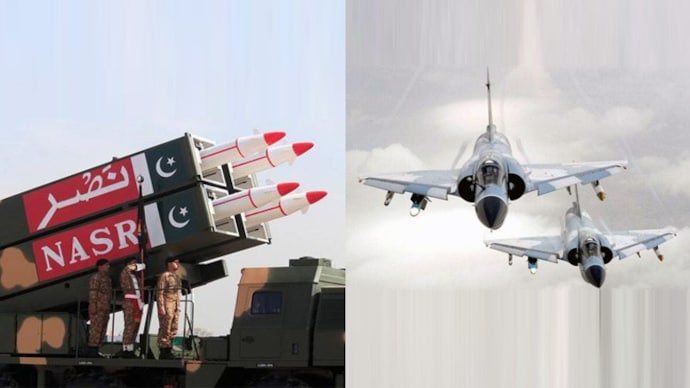Does the Air Force have a plan to take out Pakistan's tactical nuclear weapons?
With his comments about locating and fixing targets including tactical nuclear weapons in Pakistan, was Air Chief Marshal BS Dhanoa dropping a subtle hint about his force looking to take out Pakistani weapons systems such as the Nasr?

In Short
- IAF can locate, fix targets, including nuclear weapons, in Pakistan: Air Chief Marshal BS Dhanoa.
- Dhanoa was responding to a query about Pakistan's tactical nukes.
- Dhanoa's comments may have been a hint about the Nasr missile system.
"As far as the Air Force is concerned, it is not only with tactical nuclear weapons, but any target across the border, we have the ability to locate, fix and strike targets across the border," Air Chief Marshal BS Dhanoa said yesterday.
The IAF chief was answering a question at the annual Air Force Day press conference on how the IAF planned to respond to Pakistan's store of tactical nuclear weapons.
With his response, was Air Chief Marshal BS Dhanoa dropping a subtle hint about his force looking to take out Pakistan's tactical nuclear weapon launchers such as the 'Nasr'?
First tested in 2011, the Nasr weapons system has four nuclear-tipped short range missiles mounted on to an 8x8 transporter erector launcher (TEL). Each missile is believed to carry a nuclear warhead with a blast yield estimated between 0.5 kilotons to 5 kilotons (the Hiroshima bomb's yield, for comparison, was 15 kilotons).
On September 21, speaking on the sidelines of the United Nations General Assembly in New York, Pakistan's prime minister, Shahid Khaqan Abbasi, said that his country had developed tactical nukes in order to deter India's Cold Start doctrine (which calls for lightning-quick, shallow military thrusts into Pakistan at a short notice).
During a recent test-launch of the Nasr, the Pakistani army chief, General Qamar Javed Bajwa, too had made similar comments. "Nasr has put cold water on cold start," Bajwa had said after a training launch of the Nasr missile system in July this year.
Surgical strike is a decision that has to be taken by Govt of India. IAF has capability to carry out full spectrum of air ops: BS Dhanoa pic.twitter.com/gfvZxOxhmM- ANI (@ANI) October 5, 2017
Theoretically, multiple salvoes of Nasr are meant to be launched against advancing Indian battlegroups in what Pakistan terms its 'Counter-Cold Start doctrine'.
Indian Air Force chief BS Dhanoa may have talking about taking out the Nasr missile systems when he made his comments yesterday. However, does the Air Force have the ability to precisely 'locate' and 'fix' these dispersed vehicles and knock them out using air strikes?
Rajesh Rajagopalan of the School of International Studies at JNU thinks that while the IAF may have the capabilities to carry out an air strike, the force may not have the precise intelligence and information required about the missile systems' locations. "There is a huge question mark on the kind of surveillance and intelligence the IAF would need for such a task."
Notably, during the 1991 Gulf War, the United States launched over 2,000 air missions in order to find and destroy the Iraqi 'Scud' tactical ballistic missile. The 'Great Scud Hunt', however, failed to destroy even a single mobile missile or launcher. The US missiles, instead, hit fuel trucks and some decoy launchers.
Air Vice Marshal Manmohan Bahadur (retired) of the Centre for Air Power Studies thinks the air chief's statements are only meant to indicate the fact that India's nuclear doctrine is sufficient to tackle any strike by an adversary using nuclear weapons.
"Our doctrine is meant to plant the doubt in the minds of the Pakistanis whether they can test India's resolve in the employment of nuclear weapons. To extend it to say that India is planning a counterforce strategy (targeting nuclear weapons) is incorrect," he said.
THREAT OF PAK NUKES
Pakistan's tactical nukes are being seen as potentially destabilising because they delegate the ability to launch nuclear weapons to military commanders on the ground.
"Pakistan has three to four operational tactical command posts where nuclear weapons might or could be launched from... each of them is like a nuclear-armed country," former US Senator Larry Pressler said in New Delhi on September 28. The former senator, who authored the Pressler Amendment in 1990 cutting Pakistan's access to military hardware, was speaking at the September 28 launch of his book 'Neighbors in Arms'.
The possibility of counterforce options was earlier raised by former National Security Adviser Shiv Shankar Menon in his book "Choices: The Making of India's foreign policy", published this year.
Menon mentioned that Pakistan's use of nuclear weapons, even tactical nuclear weapons, would effectively free India to undertake a 'comprehensive first strike' against it. A comprehensive first strike is a strike which targets an opponent's nuclear weapons arsenal rather than cities and population centres.
